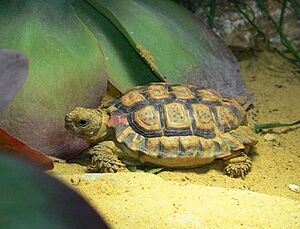Chersobius signatus facts for kids
Quick facts for kids Chersobius signatus |
|
|---|---|
 |
|
| Conservation status | |
| Scientific classification | |
| Genus: |
Chersobius
|
| Species: |
signatus
|
| Synonyms | |
|
|
The speckled tortoise (Chersobius signatus) is the smallest species of tortoise in the world. It is also known as the speckled padloper or speckled Cape tortoise. This tiny tortoise belongs to the genus Chersobius. You can only find it in South Africa, which means it is endemic to that country.
| Top - 0-9 A B C D E F G H I J K L M N O P Q R S T U V W X Y Z |
Where Does the Speckled Tortoise Live?
The speckled tortoise naturally lives in a small area of Little Namaqualand. This is a dry, desert-like region in western South Africa. These tortoises usually live among rocky areas. They search for small, juicy plants to eat among the rocks.
People used to think there were two different types of speckled tortoises. These were the Namaqualand speckled padloper and the southern speckled padloper. But now, scientists know they are all part of the same species.
What Does the Speckled Tortoise Look Like?
These tortoises are really small! Male speckled tortoises are about 6 to 8 centimeters (2.4 to 3.1 inches) long. Females are a bit bigger, growing up to almost 10 centimeters (3.9 inches) long. They weigh about 95 to 165 grams (3.4 to 5.8 ounces).
Their shell is quite flat and has slightly jagged edges. The shell is orange-brown and covered with hundreds of tiny black spots. This is how they get their name! Male tortoises have a belly that curves inward, which helps tell them apart.
You can tell this tiny tortoise apart from other similar species by its speckles. It also has five toes on its front feet. Many of its relatives only have four toes on all their feet.
Life and Habits of the Speckled Tortoise
Speckled padlopers are most active in the early morning. This is especially true in autumn and spring, which is when they mate. They live among rocky areas and eat small, juicy plants that grow between the rocks. These plants must be small enough for them to reach.
When a male and female tortoise want to mate, they nod their heads at each other. After mating, the female digs a nest in damp soil between the rocks. She lays several eggs there. The baby tortoises, called hatchlings, are very tiny. They are less than 7 grams (0.25 ounces) and about 30 millimeters (1.2 inches) long when they hatch. They come out of their eggs after about 100 to 120 days. An adult female speckled tortoise usually lays up to 5 eggs each year.
Dangers and How We Protect Them
The speckled tortoise faces several dangers. These include cars on roads, losing their natural home, and poaching. Poaching means people illegally take them from the wild to sell as pets. It is against the law to buy or sell these tortoises. Any speckled tortoises kept as pets in South Africa and Namibia are officially registered. This helps stop illegal trade.
Other dangers come from animals that are not native to the area. These include pet dogs and pigs. Many tortoises taken from their natural homes often die. This is because they find it hard to get used to new food and different environments.
However, speckled tortoises can do well in captivity if cared for properly. They need the right temperature, humidity, and a variety of food. Most problems with pet speckled tortoises happen because of bad food, too much dampness, or poor care.
See Also
- Smallest organisms


